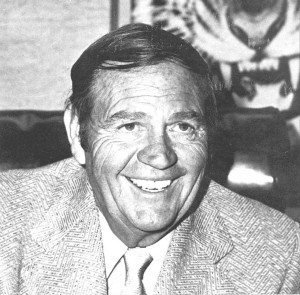 In Memoriam...
In Memoriam...
May 5, 1913- March 3, 1978
Robert William Prescott --visionary and stalwart pioneer of the air cargo industry, colorful World War II fighter ace, founder and president of Flying Tiger Line --died March 3 of cancer at his home in Palm Springs, California. He was 64.
Bob Prescott founded the Flying Tigers in 1945, and served as its only president and chief executive officer until his death, and was chairman of the airline's parent company, Tiger International.
Bob was born in Ft. Worth, Texas on May 5, 1913. After high school, he joined his father in the trucking business. In 1934 he moved to California, attended Compton Junior College and entered Loyola Law School, Los Angeles.
He left school in 1939 to enlist in the U.S. Navy as an aviation cadet, training at Pensacola, Florida. He was commissioned as an ensign in 1940, and served as a flight instructor until September 1941, when he resigned his commission to join General Claire Lee Chennault's American Volunteer Group (AVG) in China.
Prescott participated in five major campaigns while serving as a flight leader for the AVG, popularly known as 'the Flying Tigers." When the AVG was disbanded in July, 1942, he returned to the United States and began flying with the Intercontinental Division of Trans World Airlines. He was a co-pilot of the famous "Mission to Moscow" flight of Ambassador Joseph E. Davies in 1942.
Later that year he returned to China as a captain with the China National Aviation Corporation, flying military supplies into China from India over the famous "Hump." He completed more than 300 flights over the treacherous Himalayan route.
He returned to the United States in November, 1944 and on a trip to Acapulco, Mexico, met a group of Los Angeles businessmen associated with Samuel B. Mosher, Los Angeles oil pioneer and magnate. They were exploring the possibility of establishing an airfreight line along the west coasts of the United States and Mexico. Prescott convinced them that a better idea would be a transcontinental route across the United States. They agreed to match whatever capital he could raise, and Bob was appointed to find aircraft and set up the airline that was to become Flying Tiger Line.
He found 14 Navy surplus Budd Conestoga cargo aircraft and collected $89,000 from friends who had flown with him in China. This sum was equaled by Mosher's group. A month or so later, he landed his first three loads -- a planeload of grapes from Bakersfield to Atlanta, flowers from California to Detroit, and furniture from New York to California. Flying Tigers was off the ground.
A four-year fight for official government certification ended in 1949 with approval of the nation's first commercial all-cargo route.
During that time he was many times recognized as a leader in air transportation. He was a member of the board of the Transportation Association of America and had been a member of the Board of Directors of the Air Transport Association since 1969. In 1973 he was named "Man of the Year" by the National Defense Transportation Association for outstanding contributions to the field of transportation. He was active in civic affairs, was a trustee of the City of Hope, held regional industrial chairmanships in the United Crusade and was an honorary member of the Air Line Pilots Association and the Wings Club of New York. In 1977, Northrop University conferred an honorary Doctor of Science degree upon him.
Bob Prescott is survived by his wife Anne-Marie, two daughters, French Prescott and Kirchy Prescott of Los Angeles, and three grandchildren. He also leaves a sister, Mrs. Marquerite Lionberger of Ft. Worth, Texas, and a brother, L. Roy Prescott of Midland, Texas. Bob's son, Peter, was killed in an airplane crash in 1965.
A giant amidst his peers, Bob Prescott was described recently as a symbol for all men in World War II who had a dream about aviation, and of all those who worked hard to realize that dream. He was the only man who succeeded in building a scheduled airline from the more than 300 such air transport enterprises which mushroomed in the late 1940s that has survived to this day.
[envira-gallery id="12274"] Back To Memorials